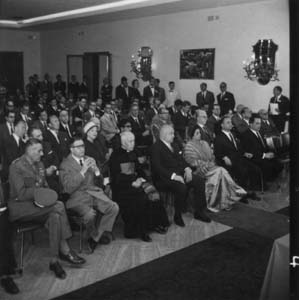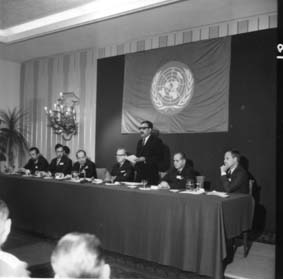Personal tools
News from ICTP 107 - Features - Birth of the Centre

Andre-Marie Hamende, who served as the Centre's first senior administrator and is now its in-house historian, recalls the period that led up to ICTP's creation.
The Birth of the Centre
 |
 |
On
5 October 1964, a group of public officials, largely from Italy,
joined eminent physicists from around the world at the Jolly Hotel
in downtown Trieste for the inaugural meeting of the newly created
International Centre for Theoretical Physics (ICTP). A seminar
on plasma physics served as a platform from which to officially
launch ICTP.
Sigvard Eklund, director general of the International Atomic Energy
Agency (IAEA), was there. So, too, was Guido Gerin, the Italian
government's representative to IAEA, as was Begum Liaquat Ali
Khan, Pakistan's ambassador to Italy.
Science luminaries included one future Nobel Laureate--Abdus Salam--and
Marshall N. Rosenbluth, a professor of physics at the University
of California, San Diego, and a former student of Edward Teller.
In all, 73 participants attended the seminar, representing 14
countries in the West, five in the East, and 12 in the South.
At the centre of the event, not surprisingly, were the two
founding fathers of ICTP: Abdus Salam and Paolo Budinich, both
of whom had worked tirelessly to see this day come to pass.
Salam, a science prodigy born in Jhang, Pakistan, who had fulfilled
his promise as professor of physics at Imperial College in London,
and Budinich, who was born in Dalmatia and hailed from a family
of sea-farers dating back to 17th century Venice (and who was
an internationally recognised theoretical physicist in his own
right), were an unusual pair--a mismatch that matched perfectly
for the task at hand.
I can hardly believe it has been 40 years since that memorable
day and I sometimes stand in wonder admiring how the Centre has
grown into a world-renowned institution, sponsoring 40 research
and training activities each year that attract more than 4000
scientists from across the globe.
The story of ICTP begins not in 1964 but in autumn 1960 when Abdus
Salam, then just 34 years old, outlined a proposal, first at the
Tenth Annual International Conference on High Energy Physics in
Rochester, New York, USA, and then before delegates attending
the General Conference of IAEA in Vienna, Austria, to create an
international centre dedicated to theoretical physics that would
pay special attention to the needs of scientists from the developing
world.
With support from several IAEA member states (mostly from the
developing world), the IAEA general assembly agreed to conduct
a feasibility study examining the 'pluses and minuses' of the
proposed centre.
I first read about Abdus Salam's idea in the French science journal,
Revue de l'Energie Nucleaire, while working as a researcher
at the Nuclear Centre of Saclay in France. I had some recollection
of Abdus Salam, but I thought he was from Algeria or Egypt. My
knowledge of Trieste was more remote and unreliable. I needed
to examine a map to determine where it was.
Who would have thought--least of all me--that within six months,
I would be working at IAEA first and then at the Centre, or that
I would spend more than 25 years--virtually my entire career-as
a staff member of ICTP.
While Abdus Salam walked--and worked--the halls of IAEA seeking
international support for the initiative, Budinich sought the
backing of Italian authorities, convincing the president of Cassa
di Risparmio di Trieste, a local bank, to provide 100 million
lire (then about US$160,000) to fund a campaign for having Trieste
serve as the 'seat' for the proposed centre.
Budinich's prevailing argument was that the Centre could help
ease East-West tensions chilled to the bone by the cold war. The
money given by Cassa di Risparmio di Trieste led to the
creation of a local committee, chaired by the city's mayor Mario
Franzil, that proved instrumental in the IAEA's decision to choose
Trieste.
Meanwhile, an external scientific panel appointed by IAEA in the
spring of 1961, which included future Nobel Laureate Aage Bohr
among its ranks, prepared a favourable response to the proposal.
Panel members cited the role that such a centre could play in
nurturing contacts between scientists in the East and West and
in assisting physicists from developing countries--a reaffirmation
of the intersecting axis between both North and South and East
and West-that Abdus Salam and Budinich had envisioned 'independently
together.'
The panel also recommended that the Centre's research and training
activities should focus on the fields of nuclear physics, solid
state physics, plasma physics and high energy physics. They forecast
a scientific staff comprised of about 30 researchers and an annual
budget in the neighbourhood of US$500,000.
The slow but clear sailing that Abdus Salam had encountered through
the first year of his ongoing effort to secure support for the
Centre soon encountered a series of obstacles set in place by
the IAEA's Scientific Advisory Committee (SAC).
The committee, which comprised its own 'heavy weight' scientists
(including Nobel Laureate Isidor I. Rabi and Homi Bhabha, the
father of nuclear energy in India), suggested that the creation
of fellowship programmes at existing centres of theoretical physics
(for example, the Institute for Advanced Study in Princeton, New
Jersey, USA) could prove a more cost-effective and easier-to-implement
response to the problems that the initiative was seeking to address.
Committee members also expressed concern that a centre for theoretical
physics would have no practical applications for developing countries
struggling to improve their living standards.
As the debate unfolded at IAEA between the panel's and committee's
competing strategies, the Italian government publicly stated that
it would provide land, buildings and US$275,000 to cover the proposed
centre's operating and programmatic costs--if Trieste was chosen
as the Centre's 'seat.'
In Autumn 1961, Sigvard Eklund, a strong believer in Abdus Salam's
vision, was appointed the director general of IAEA. With Eklund's
steady hand steering the negotiations and with adequate funds
on the table (thanks to the generosity of the Italian government),
support tilted in favour of Trieste. Still two years of additional
discussions and preparation were needed before ICTP became a reality
in Trieste. Ultimately, 57 IAEA member states voted for the proposal
and four member states abstained. No country voted against it.
Yet, over the next two years before successfully reaching the
finish line, Trieste had to contend with proposals emanating from
the cities of Copenhagen, Lahore and Vienna to host the Centre,
as well as continued suggestions that the issues raised by the
proposal could be better addressed by bolstering existing centres
rather than creating a new one.
Indeed Eklund bowed to these latter concerns by requesting another
assessment of the proposal in the spring of 1963-the third comprehensive
review conducted since Abdus Salam first floated the idea in 1960.
Robert E. Marshak (University of Rochester, New York, USA), Jaime
Tiomno (Centro Brasileiro de Pesquisas Fisicas, Rio de
Janeiro, Brazil), and Leon van Hove (CERN, European Organisation
for Nuclear Research, Geneva, Switzerland)--eminent physicists
who had worked at the Institute for Advanced Study in Princeton
under J. Robert Oppenheimer--were asked to come to Vienna to prepare
the study.
Their unwavering, enthusiastic endorsement proved critical for
Trieste as the decision-making process headed into the home stretch.
Emphasising that training for research at the Centre would be
as important as the research that would take place there, the
reviewers contended that the Centre could indeed help promote
the advancement of theoretical physics in developing countries
by enabling scientists to continue their work and interact with
colleagues from around the world.
On 13 June 1963, the IAEA board of governors approved the proposal
for the creation of an International Centre for Theoretical Physics
(ICTP) in Trieste and on 19 September 1963 the board adopted the
draft agreement with the Italian government.
The launching pad for the Centre, meticulously constructed over
the past several years, was finally in place. The official take-off
for ICTP would occur one year later at the Jolly Hotel in downtown
Trieste. The rest, as they say, is history.
Andre-Marie Hamende
ICTP Senior Administrative and Scientific Information Officer
(1964-1990)